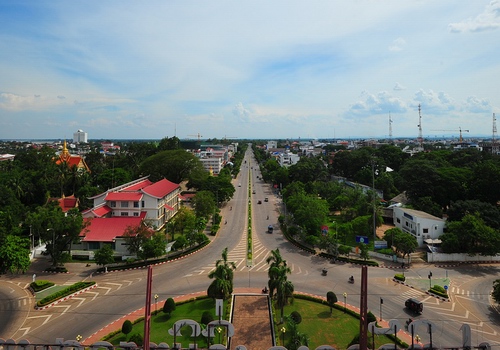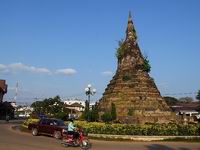|
Vientiane
 Located
serenely on the north bank of the broad, languid Mekong River, Vientiane
is a very modest capital. It's heart is compact and easily accessible on
foot, with bakeries and cafes never too far away. Paddy fields still dot
the suburbs, extending close to the city center in places. Located
serenely on the north bank of the broad, languid Mekong River, Vientiane
is a very modest capital. It's heart is compact and easily accessible on
foot, with bakeries and cafes never too far away. Paddy fields still dot
the suburbs, extending close to the city center in places.
Its still a sleepy place, despite the rise in traffic over the last few
years, and the town is dotted with fine examples of Laotian temple
architecture and French colonial buildings, some tastefully restored,
most crumbling. Charming lanes run off the main streets in the heart of
town, leading to scenes of life that have changed little over the last
few decades.
For the visitor, Vientiane, despite its urbanity, remains quirky while
its people are almost as pleasantly relaxed as their rural cousins.
Vientiane is also a chance to step back in time to gain an impression of
what neighbouring Thai provincial towns were like before breakneck
industrialization swept the kingdom.

Vientiane is more
colourful and cheerier than any communist European capital. Most
places of interest are concentrated in a small area around parallel
Setthathirat and Samsenthai roads, including the commercial and
administrative districts. Its easy to explore on foot along shady
avenues and streets stretching from the pleasant Mekong riverside to
Talaat Sao, the morning market.
Surrounded by a lush garden, Wat Si Saket is one of Vientianes
oldest temples, although not the oldest Buddhist site - many temples
were destroyed during wars in the 19th century. A large wat bearing
a strong Thai influence with some fine, but fading Buddhist murals,
its home to over 6000 Buddhas of varying sizes and styles. More
tranquil than most temples, its worth lingering for a few extra
moments in the pleasant garden before returning to the dusty
streets.
10 minutes walk west along Setthathirat Rd is Wat Ong Teu Mahawihan,
one of the centers of Buddhist theology in
Laos. The place never
seems overrun with monks. Interesting features include intricate
carvings, a large bronze Buddha and a big drum atop a tower.
Hop in a tuk-tuk for a 10-minute ride, via the Arc de Triomphe-like
Patuxai, along some could-be-grand avenues to Pha That Luang, a
very-sacred, castle-like symbol of Buddhism and the Laotian state.
The stupa dates back 400 years, although it was rebuilt early last
century. The design embodies Buddhist ideas about ascending to
Nirvana, and of course depicts many Buddhas. Theres a few grand
buildings, apart from Pha That Luang, the symbol of national
sovereignty and Buddhism, the unfinished 1969 Patuxai national
monument, and the new Chinese-financed cultural center.
Charting the history of the Pathet Laos march to victory, the Lao
Revolutionary Museum is something of a gem as there aren't too many
communist propaganda halls like this left. Housed in a sprawling
mansion on Samsenthai Rd, exhibits include maps, uniforms, and guns
used by Laotians or imperialists. There's also a small exhibition on
Laotian culture, geography and geology, which seems to be an
afterthought. Open 8-11.30am and 2-4.30pm, weekdays.
Once the Royal Temple, Haw Pha Kaew houses many royal religious
artifacts including a throne, manuscripts and bronze drums. Also
here are a number of Buddhas, plus a good collection of Laotian
Buddhist sculpture. Although it is no longer a temple, some still
make offerings on top of a wooden Naga. Open 8-11.30am and 2-4.30pm,
Tuesday to Friday.
Kaysone Phomvihane Museum is dedicated to the life of the Pathet Lao
leader who directed wartime communist forces from a cave in
northeast, and became Laos first post-war leader. Its a cult-like
place, following his life from a boy in southern Savannakhet
province to guerilla leader and architect of a postwar workers
utopia. Open 8-11.30am and 2-4.30pm, Tuesday to Friday.
Entertainment and Eating Out
Although Vientianes nightlife and dining scene has picked up over
the last few years, the place isnt overrun with clubs and
restaurants. Most streets are deserted by midnight. A few bars and
plenty of restaurants, many al fresco and informal, line Fa Ngum St
along the Mekong between Chao Anou and Mahosot streets. One block
north along Setthathirat Rd and the streets leading to it from Fa
Ngum, are more restaurants and bars, including the well-established
Sam Lo. These tend to be more upmarket, but still very good value.
Chess Club on Mahosot St is worth seeking out. There are a few
bakeries along Setthathirat and Chao Anou. Just off Setthathirat is
Nam Phu, the Fountain Circle, which is a pleasant place for drinks.
Around it are a few Italian and French restaurants, plus a Swedish
bakery.
Talaat Sao, the morning market, actually runs all day and is a great
place to join locals for a bowl of noodles or grilled chicken.
Baguettes with local pat are also plentiful here.
In the evenings, Chao Anou St and a few of the side
 streets draw
stalls selling bean curd and noodles. There are also a few
restaurants here that do noodles and chicken or duck rice. streets draw
stalls selling bean curd and noodles. There are also a few
restaurants here that do noodles and chicken or duck rice.
At
the far end of Chao Anou, beyond Samsenthai St near Khun Bulom St is
a night market selling pungent curries, grilled chicken, spicy
salads and other specialties. Often takeaway only.
|